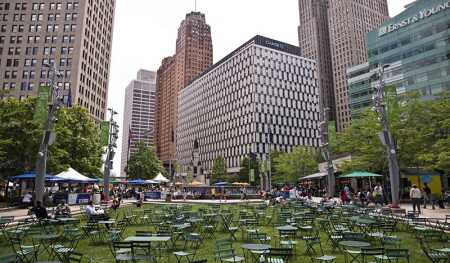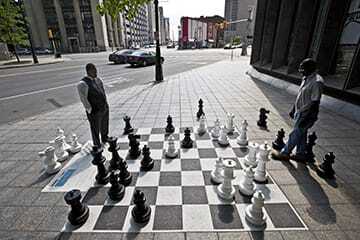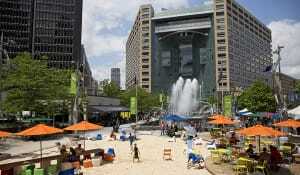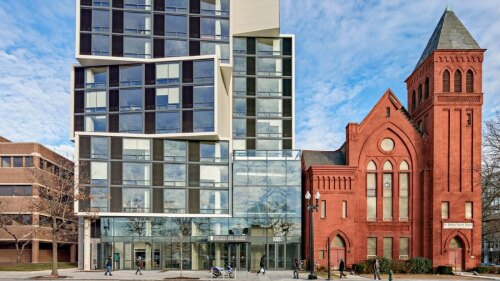In downtown Detroit at 611 Woodward Avenue—a building designed in the late 1950s by noted industrial architect Albert Kahn—dozens of Quicken Loans mortgage bankers are talking a mile a minute into their headsets. The room resembles the buzzing hive of a trading floor, but with more whimsy and color.
Walls in the building now called the Qube (and formerly known as Chase Tower) are painted lime green, magenta, and bright orange. Each banker has an enlarged selfie attached to his or her desk. Photos of top sellers decorate the room’s perimeter. All the desks can be adjusted for height, so some bankers sit while others stand in front of multiple computer screens displaying real-time data. Still others roam around with their headsets on. Cheers and high-fives occasionally punctuate the atmosphere of the room, drowning out the hum of conversation and background music.
Welcome to the Quicken Loans operations center, where these bankers rake in roughly $7 billion in home loan sales per month, making Quicken the largest retailer of online mortgages in the United States. The operations center is also one of the frontiers in a massive and historic revitalization effort underway in Detroit—a city that has yet to emerge from an $18 billion bankruptcy filed in July 2013, and that has $850 million worth of blighted structures and vacant lots to rehabilitate, according to the White House–commissioned Detroit Blight Removal Task Force.
Remaking Detroit is an enormous undertaking. One of the private sector pioneers in remaking the city is Detroit native Dan Gilbert, majority owner of the Cleveland Cavaliers professional basketball team and chief executive officer of Quicken Loans and Rock Ventures, the umbrella entity encompassing Gilbert’s business and real estate enterprises. All told, Gilbert has invested $1.3 billion in mostly commercial real estate, represented by more than 60 properties in the city’s central business district. Since 2010, Gilbert has moved employees from Livonia, Michigan, into several downtown office buildings, including the Qube; there are now 12,000 of them working across 9 million square feet (836,000 sq m) of office space.
Despite these efforts, Gilbert knows he cannot save Detroit by himself. To get more people living, working, and playing in Detroit, Gilbert and other civic leaders say, innovative partnerships among city government, local nonprofit entities, foundations, small businesses, and fellow private investors will be required. Luckily, Gilbert has plenty of company in his campaign.
A question-and-answer session with Gilbert opened ULI’s June conference on public/private partnerships, which was held at Detroit’s historic Book Cadillac building, home to the city’s most opulent hotel in the 1920s and now—in an effort to recapture past glory—a Westin hotel and luxury condos. In the session, Gilbert said he wants “to encourage everybody and anybody” who might contribute to this uncertain chapter in the city’s history.
“For us, the more the merrier,” he said.
Digital Startups
The birthplace of the American car industry, Detroit has not fared as well as the Big Three automakers—Ford, Chrysler, and General Motors—since the Great Recession starting in 2008, when the city’s unemployment rate rose to 21 percent and the federal government approved a multibillion-dollar bailout of the automakers. Since then, the auto companies, despite GM’s recent turmoil over faulty ignition switches, have rebuilt themselves, posting robust sales in 2013—the same year that the city of Detroit declared bankruptcy and that emergency manager Kevyn Orr took over the city’s balance sheet.
While few are betting on the Big Three to revive Detroit’s economy, civic leaders are looking to cleaner industries to claim the city as their own. Several tech companies have set up shop downtown, many of which are under the aegis of Rock Ventures, but others, like Twitter and Microsoft Ventures, have also been drawn to the city.
Unlike the auto industry, digital startups such as Twitter and Microsoft Ventures require little capital to launch but can build wealth quickly, as evident in the recent initial public offerings (IPOs) of some leading tech companies, said Gilbert. He has created what essentially is a corporate campus along Woodward Avenue and other downtown streets to house more than 120 businesses in properties managed by his real estate company, Bedrock Real Estate Services. In addition to law firms, construction and architecture firms—and even one auto company, Chrysler—digital startups like Quikly, Ignition One, and Social 2 Step are renting space.
And it’s not just startups that are players in Detroit’s new economy. Compuware, a Fortune 500 company that sells its IT software to clients around the world, was an early pioneer to downtown, relocating from Farmington Hills, Michigan, in 2003. The company’s headquarters, which faces Campus Martius Park, the crown jewel of Detroit’s urban core and winner of the inaugural ULI Amanda Burden Urban Open Space Award in 2010, appealed to Gilbert so much that he rented four floors for Quicken Loans’ corporate offices.
Technology companies have a reputation for being more comfortable with risk than capital-intensive industries, such as the automobile industry. In Gilbert’s view, risk avoidance and fear of failure—along with complacency—are what led to Detroit’s stagnation in the first place.
Gilbert says he hopes to inject risk-taking energy into the city through Bizdom, Rock Ventures’ small-business accelerator that provides seed capital, mentoring, and work space to entrepreneurs and tech startups. “If you’re not playing in the technology and entrepreneurial environment, then I don’t think your city, state, or country is going anywhere,” Gilbert said at the ULI conference.
Broke and Broken
Excitement about Detroit’s future is tempered by the realization that the city is broke and large areas resemble a ghost town. A city that boasted a population of 1.8 million in 1950 now has fewer than 700,000 residents.
“It’s not just that the city is broke and unable to pay its bills,” State Representative John Walsh (R-Livonia) said at the ULI conference. “It’s broken. It cannot operate.”
In 2012, the city’s general fund had a $327 million deficit, and its credit rating from Moody’s—B3—was lower than that of any other major American city. In 2013, it took an average of 58 minutes for the Detroit Police Department to respond to emergency calls, although response times to “prority one,” or critical, calls are said to be improving under James Craig, the new police chief, according to media reports.
Walsh said that Detroit’s future rests on whether it can emerge from bankruptcy later this year. The city owes roughly $18 billion to 170,000 creditors, including 30,000 public sector pensioners, who must sign off on the city’s restructuring plan.
The state of Michigan also is heavily dependent on Detroit’s emergence from bankruptcy since it impairs surrounding jurisdictions’ ability to finance debt, Walsh said. In May, lawmakers signed off on a deal—known as the “grand bargain”—that sent $195 million in state funds to Detroit to shore up pensions, removing the billion-dollar art collection housed at the Detroit Institute of Art as a bargaining chip. Nine philanthropies, including the Kresge and Ford foundations, pledged more than $350 million toward the city’s pension obligations.
In conjunction with Data Driven Detroit, a nonprofit organization dedicated to providing accessible high-quality data to aid decision makers, and Loveland Technologies, a local company that develops online tools for urban blight eradication, the Detroit Blight Removal Task Force dispatched 150 residents to survey more than 378,000 properties around the city’s 139-square-mile (360 sq km) footprint. Armed with smart phones, residents logged their findings into a searchable database called “Motor City Mapping” through a “blexting” (blight + texting) app.
Cochaired by Gilbert, the task force had the following goal: to capture hard numbers documenting the many abandoned structures and vacant lots that are visible along neighborhood streets skirting downtown. Residents identified nearly 85,000 structures and lots as blighted and in need of intervention, and it would require $850 million to fix the problem, according to the task force’s 330-page report.
Gilbert views blight, which he compared to a “malignant cancer,” as the single greatest barrier to addressing Detroit’s other top priorities: creating job opportunities, overhauling the schools, and reducing crime. “You can’t remove part of it or it grows back,” he said. “You have to take the entire thing out.”
Attracting New Residents
Luring people back to the city as workers and residents will be essential to Detroit’s turnaround. Several initiatives going on right now—corporate investment, job creation, retail construction, the development of inviting green spaces, and the development of the M1 streetcar line along Woodward Avenue—are geared toward attracting young people to establish roots in Detroit.
But to accomplish this, the city will have to address a serious shortage of workforce and market-rate housing. The irony of this shortage is that many of the blighted structures awaiting demolition are single-family homes. The city has set up an auction process through which blighted homes can be purchased for as little as $1,000 if owners commit to bringing them up to code and having them occupied within six months. Nonprofit groups Detroit Future City and Midtown Detroit have launched a Blight Bootcamp to teach residents how to rehabilitate properties.
“Our challenge is the fact that the demand is far exceeding the supply,” said Cari Easterday-Kar, chief financial officer of Midtown Detroit, which also administers Live Downtown/Live Midtown, an incentive program for employees of downtown businesses who want to rent or purchase a home in surrounding neighborhoods. New homeowners, for example, can qualify for a $20,000 forgivable loan toward their purchase, and renters are eligible to receive a $2,500 subsidy toward rent their first year.
Launched in 2011, the Live Downtown/Live Midtown program has served over 600 renters and a few dozen buyers who work at the businesses participating in the program. There are, however, roughly 15,000 people who would move downtown if the housing stock were adequate, according to “7.2 SQ MI,” an upcoming report on Detroit housing, demographics, and economic development. Several market-rate apartment buildings have waiting lists even as young professionals—the very ones municipal leaders want to attract—are being priced out by higher rents. Landlords are routinely raising rents by $200 to $400 per month because of “high demand and almost nonexistent new supply,” the Detroit Free Press wrote in January. Several new residential projects are in the works, including new condominiums in the historic David Whitney Building, named after a Detroit lumber baron. Yet the market forces necessary for the kind of large-scale, high-density residential development found in other cities have not taken hold in Detroit. “Lenders are looking for strong market studies year after year,” said Easterday-Kar. “The conditions aren’t necessarily there yet, but I would also note they are improving based on the demand for housing we are seeing.”
Public safety also remains a concern for potential residents as the city contends with high rates of violent crime, and the Detroit Police Department (DPD) attempts to rebuild its workforce, morale, and public image. To convince employees to work downtown, Gilbert built a state-of-the-art security system that features hundreds of cameras to monitor Gilbert’s downtown properties and the surrounding streets and sidewalks. He created a private security force, Rock Security, to supplement a resource-stretched city force. (Many DPD officers moonlight for Rock Security after their shifts.)
Nonprofit groups are also leading the charge in creating inviting public open spaces to build on Campus Martius Park’s momentum as a driver of investment. Detroit Future City (DFC) has issued a comprehensive 50-year framework of how the city can revitalize neighborhoods through better zoning and land use planning. With its 139-square-mile (360 sq km) footprint, Detroit is one the nation’s least densely populated cities, and much of its infrastructure was designed for a larger population and is costly to maintain, according to the DFC framework.
Vacant land that is now considered a liability could be turned into an asset through the creation of a network of well-maintained open spaces, said Kenneth Cockrel Jr., a former Detroit City Council member and DFC executive director. Considering the staggering amount of vacant land in the city—20 square miles (52 sq km), equivalent to the footprint of Manhattan—the impact could be huge. “It is one of the key things that could reinvent the city of Detroit,” Cockrel said.
Archana Pyati is an impact writer for ULI.









